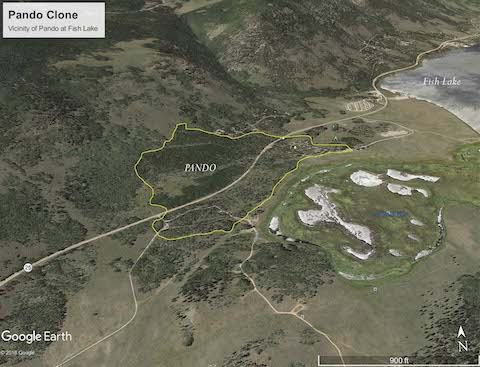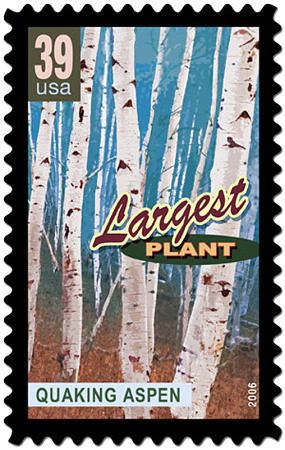
If you’ve ever walked through an aspen grove, you’ve seen hundreds or thousands of white trunks propping up a sky of silvery green leaves trembling in the wind.
In the fall, all the leaves in one grove will go from green to gold at the same time.
This is because the entire grove is really just one organism, a massive root system from which many trunks sprout, grow, die, and are replaced by new trunks.
The largest aspen grove in the world, in Utah, is named Pando: Latin for “I spread out.”
It sprouted 80,000 years ago from a seed the size of a pepper grain and now supports almost 50,000 trunks, making it the heaviest living thing in the world—and one of the oldest.
But Pando is slowly declining. Most of its trunks are now more than 100 years old; new ones aren’t growing to take the places of those that die.
Researchers think it has to do with elk and mule deer. A century ago, ranchers and trappers removed their natural predators from the area. Local populations of elk have grown to more than 77,000 and mule deer to 300,000.
And the grazing elk and deer are eating the aspen saplings.
Studies that fenced off sections of the grove have seen young trees return, growing 10 feet in just a few years.
Ranchers don’t want to reintroduce non-human predators, who might endanger their livestock.
So, the solution may be to fence Pando to protect it from deer. Or to change hunting practices to thin the herds.
Background
Synopsis: For 80,000 years, a giant has lived in the Fishlake National Forest of southern Utah. Pando the “Trembling Giant” is a clonal colony of quaking aspen (Populus tremuloides) with more than 47,000 trunks, making it the heaviest living organism on Earth—as well as one of the oldest. But this behemoth is under threat. While trees deteriorate and die routinely in aspen groves, for the past few decades, Pando’s new growth has not kept up, primarily because of challenges of grazing cattle and deer.
- One of Earth’s largest organisms lives in the Fishlake National Forest in southern Utah.
- It is a “clonal colony” of quaking aspen; genetic analysis has shown the entire forest is one single male individual connected by a massive root system.
- It was discovered in 1968 and studied for decades before being named the world’s largest organism in 1992. (The “Humongous Fungus” in Oregon now holds the title for a single organism with the largest areal extent.)
- Researchers named the huge aspen “Pando,” which is Latin for “I spread out.”
- Quaking aspen leaves flutter in even the gentlest of breezes, making a distinctive rustling sound and allowing light to filter through to the understory. This environment supports a diverse woodland ecosystem of grasses, mosses, and lichens.
- The leaves on these beautiful white-barked trees turn bright gold in the fall, colony by colony, so you can pick out different individual clones from a distance.
- Pando sprouted from a single seed the size of a pepper grain and grew larger and larger by producing stems to support its massive, spreading root system.
- Pando is the size of 80 American football fields (106 acres, 43 hectares), twice the size of the next largest aspen clone. Its location on a flat plain may have enabled it to out-compete other nearby aspen groves.
- Its weight has been estimated at 13 million lbs (6,000 metric tons). It is the heaviest-known organism on Earth.
- It contains more than 47,000 stems (trunks) of aspen trees with an average age of 130 years.
- Pando’s root system is believed to be 80,000 years old, which would make it one of Earth’s oldest living organisms.
- Pando grew under ideal circumstances for most of its life, its massive root system surviving fires, landslides, and floods.
- In fact, competitor conifers died during intense fires, while Pando’s massive root system survived to send up new stems.
- Aspen trunks routinely die and are replaced with new stems that form by “suckering” from the roots to create erect stems that grow into new aspen trees.
- The long-term health of the organism comes from having a wide range of ages for the stems, so that if a layer dies, there is another waiting to replace it.
- However, over the past 30–40 years, Pando has stopped spreading and is showing signs of decline; some think it may even be dying. In photos from the 1930’s, the crowns of the aspen trunks touched each other; today there are gaps between the mature trees.
- The problem is that older trunks are dying, as usual, but fewer young trees are replacing them. It has been compared to a retirement community with a population of 47,000 octogenarians; middle-aged trees and younger generations are absent.
- Researchers are considering a variety of causes for the decline, including fire-suppression techniques and recent droughts that weakened the aspen, making it prone to disease and insect damage. But most agree that the principal cause of Pando’s decline is trampling and overgrazing.
- Natural predators of mule deer and elk have been eliminated in the region, and for decades, herds have been eating the young aspen saplings before the clonal grove can regenerate to fill in for the dying stems. Local populations of elk have grown to more than 77,000 and mule deer have grown to 300,000, benefitting the local hunting industry but exposing Pando to additional human traffic.
- On top of that, some ranchers have access to graze cattle in the area for a couple of weeks each summer.
- Foresters have set up 65 experimental plots to learn more about Pando’s ability to recover. Some are fenced, some are fenced with selective cutting, and others are left untouched. And there is hope!
- Once fenced, the young aspen saplings thrive, increasing nearly tenfold in number.
- Young protected trees have grown tens of feet in just a few years.
- But some mule deer are able to jump the 8 ft (2 m) game fences that have been erected to protect the grove.
- Hunting to reduce the local deer population is a tactic being employed in addition to the fencing program.
- Landowners in the region do not support reintroduction of predators that might keep the deer and elk in check because the predators would also threaten their livestock.
- Pando is located just southwest of Fish Lake on Utah State Highway 25. You can spend the night inside the trembling giant at U.S. National Forest Doctor Creek Recreation Campground.

- In 2006, the U.S. Postal Service published a stamp commemorating Pando as one of the “40 Wonders of America.”


